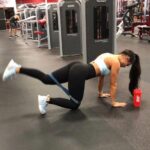Are you feeling lost and overwhelmed by the idea of starting a fitness routine? If your thought process is “I need a fitness routine” then you’re not alone. Many people struggle with understanding the importance of incorporating regular physical activity into their lives. In this article, we will help demystify the world of fitness routines and guide you through the process of creating a personalized plan that works for you.
First, we will delve into the significance of having a fitness routine and how it can positively impact your overall health and well-being. We’ll discuss the various components that make up a well-rounded fitness routine, including cardio, strength training, flexibility, and balance exercises.
Next, we’ll explore how to assess your individual fitness goals and needs to determine what type of routine will best suit you. Once you understand your personal requirements, we’ll help guide you in creating a personalized fitness plan by choosing the right exercises that align with your goals.
This is just the beginning of our journey towards establishing an effective fitness routine that works for you. We’ll also provide tips on staying consistent and motivated as well as tracking your progress along the way. Lastly, we’ll address potential obstacles like setbacks and plateaus, offering strategies to overcome them. So if you feel like shouting “I need a fitness routine“, fear not – help is on its way.
Assessing Your Fitness Goals and Needs
When it comes to starting a fitness routine, the first step is to assess your own fitness goals and needs. This is an essential part of creating a personalized plan that will work best for you. Whether you are looking to lose weight, build muscle, increase flexibility, or simply improve your overall health, understanding your specific goals will help guide you in choosing the right type of fitness routine.
Understanding Your Fitness Goals
Before diving into any fitness routine, it’s important to take some time to identify what you hope to achieve. Are you looking to improve your endurance and cardiovascular health through activities like running or cycling? Or perhaps you have strength and muscle building goals that would be better suited with weight training or bodyweight exercises. By clearly defining your fitness goals, you can narrow down the types of exercises and routines that will support your objectives.
Assessing Your Current Fitness Level
In addition to setting clear goals, it’s crucial to honestly assess your current fitness level. This can help in determining where you are starting from and what steps need to be taken in order to achieve your desired outcomes.
Take note of any physical limitations or existing health conditions that may impact the type of exercises you can do. Understanding both your aspirations and limitations will allow you to tailor a fitness routine that is not only effective but also safe for you.
Consulting With a Professional
For those who are unsure about their fitness goals or how to properly assess their needs, seeking advice from a professional such as a personal trainer or fitness coach can be incredibly beneficial. These experts can provide guidance on setting realistic goals, evaluating your current level of fitness, and developing a personalized plan specifically designed for you. Consulting with a professional can give you the confidence and direction needed to start on the right track towards achieving your fitness goals.
Exploring Different Types of Fitness Routines
When it comes to building a fitness routine, it’s important to understand the different types of exercises that can contribute to a well-rounded plan. Incorporating a variety of workout styles is essential for overall health and fitness. Here are some key types of fitness routines that you can consider including in your personalized plan:
- Cardiovascular Exercise: Cardio workouts are crucial for improving heart health and burning calories. This type of exercise includes activities like running, cycling, swimming, and jumping rope. It’s a great way to improve endurance and stamina.
- Strength Training: Strength training involves using resistance to build muscle strength and endurance. This can be done through weightlifting, bodyweight exercises, or using resistance bands. Including strength training in your routine helps with bone density and metabolism.
- Flexibility and Balance: Flexibility exercises like yoga or stretching help improve range of motion and reduce the risk of injury. Balance exercises are important for stability and fall prevention, especially as we age.
Considering these different types of fitness routines allows you to create a well-rounded plan that addresses various aspects of physical health. Whether you’re aiming to improve cardiovascular endurance, build strength, increase flexibility, or enhance balance, incorporating these elements into your routine is essential.
Ultimately, when creating your personalized fitness plan, it’s crucial to select exercises that align with your specific goals and needs. Tailoring your routine to fit your lifestyle will help you stay motivated and committed in the long run, ensuring that you see the progress you desire. Remember that the key is finding a balance between these different types of workouts in order to achieve comprehensive results.
Creating a Personalized Fitness Plan
When it comes to creating a personalized fitness plan, the key is to choose exercises that align with your fitness goals and cater to your individual needs. Whether you’re aiming to lose weight, build muscle, improve flexibility, or enhance overall physical performance, selecting the right type of exercises is crucial in achieving optimal results.
To begin creating your personalized fitness plan, start by assessing your current fitness level and any specific areas you’d like to target for improvement. Consider factors such as your age, current health condition, exercise preferences, and any past injuries or limitations that may affect the types of exercises you can safely perform.
Once you have a clear understanding of your fitness goals and needs, it’s important to explore different types of exercises that can help you achieve those objectives. Cardiovascular exercises such as running, cycling, or swimming are great for improving endurance and burning calories.
Strength training exercises like weightlifting or bodyweight exercises are ideal for building muscle and increasing overall strength. Flexibility and balance exercises such as yoga or Pilates are beneficial for enhancing range of motion and reducing the risk of injury.
It’s essential to incorporate a variety of different exercises into your fitness routine in order to promote overall physical fitness and prevent boredom. By including a mix of cardio, strength training, flexibility, and balance exercises, you can ensure that your body receives a well-rounded workout while also staying engaged in your fitness routine.
| Fitness Goals | Recommended Exercises |
|---|---|
| Weight Loss | Cardio (running, cycling), Strength Training (full body workouts) |
| Muscle Building | Strength Training (weightlifting), High-intensity Interval Training (HIIT) |
| Flexibility Improvement | Yoga, Pilates |
Implementing Your Routine
Once you have created a personalized fitness plan, the next step is implementing it and staying consistent with your routine. To do this, it’s important to find ways to stay motivated and overcome any potential obstacles that might come your way.
One effective tip for staying consistent with your fitness routine is to schedule your workouts just like any other appointment or commitment in your calendar. This will help you prioritize exercise and make it a non-negotiable part of your day.
Another helpful tip is to find an exercise routine that you genuinely enjoy. Whether it’s swimming, dancing, hiking, or a group fitness class, finding an activity that you look forward to can help make it easier to stick to your routine. Additionally, setting specific and achievable goals can provide motivation and a sense of accomplishment as you progress in your fitness journey.
It’s also important to acknowledge that setbacks and plateaus are normal parts of the process. Recognizing these challenges and finding ways to navigate through them is crucial for long-term success. This might involve adjusting your workout schedule, seeking support from friends or family, or even trying out new types of exercises to keep things fresh and exciting. Ultimately, finding what works best for you will help you maintain consistency with your fitness routine in the long run.
| Tips for Staying Consistent | Benefits |
|---|---|
| Schedule workouts in calendar | Prioritize exercise as non-negotiable commitment |
| Find enjoyable activities | Increase adherence to exercise routine |
| Set specific goals | Provide motivation and sense of accomplishment |
Tracking Your Progress
When it comes to sticking to a fitness routine, one of the most important aspects is tracking your progress. Monitoring your progress allows you to see how far you’ve come and helps you make adjustments to your plan to continue improving. Whether you’re trying to lose weight, gain muscle, improve endurance, or simply maintain overall health, tracking your progress is essential for success.
Importance of Tracking Your Progress
Monitoring your progress not only provides motivation but also helps you identify what’s working and what’s not. By keeping track of your workouts, diet, and other relevant factors, you can make informed decisions about adjusting your fitness routine for better results. Whether it’s seeing an increase in weight lifted during strength training or noticing improvements in running time during cardio sessions, tracking progress can keep you focused and on track toward meeting your fitness goals.
How to Track Your Progress
There are many ways to monitor and track your progress in a fitness routine. Keeping a workout journal where you record your exercises, sets, reps, and weights used can help you see improvements over time.
Additionally, taking regular body measurements such as weight, body fat percentage, and circumference measurements can provide valuable data on changes in your body composition. Lastly, using wearable fitness trackers or apps can help automate the process of monitoring things like step count, heart rate during workouts, and even sleep quality – all of which can impact your overall fitness progress.
Adjusting Your Fitness Routine
Once you’ve been tracking your progress for some time, it’s important to analyze the data and make adjustments to your fitness routine as needed. If you notice that certain exercises are not yielding results or if you’ve hit a plateau in your progress, consider making changes such as adding new exercises, increasing intensity or duration of workouts, modifying rest periods between sets or incorporating new types of training altogether to keep challenging yourself physically.
By being proactive about adjusting your fitness routine based on the results you’re seeing from tracking progress, you ensure that you continue moving closer towards achieving your goals.
Overcoming Obstacles
Life is unpredictable and so is the fitness journey. Setbacks and plateaus are common occurrences when it comes to following a fitness routine. It’s important to understand that setbacks and plateaus are a natural part of any fitness journey, but they don’t have to derail your progress. Here are some tips for overcoming obstacles and staying on track with your fitness routine:
- Stay patient and persistent: Understand that reaching your fitness goals takes time and consistency. It’s important to stay patient and not get discouraged when faced with setbacks or plateaus.
- Reassess your goals: If you find yourself facing a setback or plateau, take the time to reassess your fitness goals. Maybe you need to adjust your goals based on your current abilities and lifestyle.
- Try something new: Plateaus often occur when your body gets used to the same routine. Try switching up your workout by incorporating new exercises or activities. This can help shock your body into making progress again.
When dealing with setbacks or plateaus in your fitness routine, it’s essential to stay positive and focused on the bigger picture. Remember that everyone faces challenges on their fitness journey, but with the right mindset and strategies, you can overcome them and continue making progress towards your goals.
Remember that seeking professional help from a personal trainer or fitness coach can also provide valuable support and guidance when facing obstacles in your fitness routine. They can offer personalized advice, motivation, and accountability to help you navigate through setbacks and plateaus effectively.
Seeking Professional Help
In conclusion, establishing and maintaining a fitness routine is essential for overall health and well-being. Whether you are looking to lose weight, build muscle, increase flexibility, or simply improve your cardiovascular health, having a personalized fitness plan can make a significant impact on achieving your goals. It is important to take the time to assess your fitness needs and goals before exploring different types of routines such as cardio, strength training, flexibility, and balance exercises.
Once you have chosen the right exercises for you, implementing and staying consistent with your routine is crucial. It’s natural to experience setbacks and plateaus along the way, but tracking your progress and making necessary adjustments can keep you motivated and on track. In some cases, seeking professional help from a personal trainer or fitness coach can provide additional support and expertise in creating an effective routine tailored to your specific needs.
Ultimately, finding the right fitness routine is a journey that requires dedication and perseverance. Remember that it’s okay to ask for help when needed, especially when it comes to seeking professional guidance.
With the right mindset and resources in place, achieving your fitness goals is entirely possible – all it takes is commitment and the willingness to put in the work. So if you find yourself saying “I need a fitness routine,” know that with determination and support, success is within reach.
Frequently Asked Questions
How Do I Find a Good Workout Routine?
Finding a good workout routine involves understanding your fitness goals and preferences. It’s important to incorporate a mix of cardio, strength training, and flexibility exercises for overall fitness. Experiment with different routines until you find one that works for you.
What Is a Good Routine to Get Fit?
A good routine to get fit should include a combination of cardiovascular exercises, such as running or cycling, strength training with weights or resistance bands, and flexibility exercises like yoga or stretching. Consistency is key, so aim for at least 150 minutes of moderate-intensity exercise per week.
How Do I Start a Fitness Routine?
Starting a fitness routine begins with setting clear goals and creating a plan that includes realistic expectations and manageable steps. It’s helpful to start slowly and gradually increase the intensity and duration of your workouts over time. Additionally, seeking guidance from a fitness professional can provide valuable support in starting out on the right foot.

Passionate about providing useful information to anyone with an interest in the field of Personal Training, I strive to pass on to our readers quality information and to answer any questions about Personal Trainers, the work they do and how to become one.





